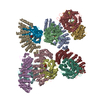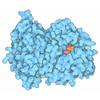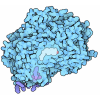[English] 日本語
 Yorodumi
Yorodumi- EMDB-2403: Structure of Human C3bBb convertase bound to a fragment of Properdin -
+ Open data
Open data
- Basic information
Basic information
| Entry | Database: EMDB / ID: EMD-2403 | |||||||||
|---|---|---|---|---|---|---|---|---|---|---|
| Title | Structure of Human C3bBb convertase bound to a fragment of Properdin | |||||||||
 Map data Map data | Structure of Human C3bBb convertase bound to a fragment of Properdin | |||||||||
 Sample Sample |
| |||||||||
 Keywords Keywords |  properdin / C3b / AP C3 convertase / complement / properdin / C3b / AP C3 convertase / complement /  electron microscopy / electron microscopy /  EM EM | |||||||||
| Function / homology |  Function and homology information Function and homology informationcytoplasmic side of Golgi membrane /  alternative-complement-pathway C3/C5 convertase / alternative-complement-pathway C3/C5 convertase /  classical-complement-pathway C3/C5 convertase complex / positive regulation of opsonization / Defective B3GALTL causes PpS / O-glycosylation of TSR domain-containing proteins / oviduct epithelium development / C5L2 anaphylatoxin chemotactic receptor binding / regulation of triglyceride biosynthetic process / complement binding ...cytoplasmic side of Golgi membrane / classical-complement-pathway C3/C5 convertase complex / positive regulation of opsonization / Defective B3GALTL causes PpS / O-glycosylation of TSR domain-containing proteins / oviduct epithelium development / C5L2 anaphylatoxin chemotactic receptor binding / regulation of triglyceride biosynthetic process / complement binding ...cytoplasmic side of Golgi membrane /  alternative-complement-pathway C3/C5 convertase / alternative-complement-pathway C3/C5 convertase /  classical-complement-pathway C3/C5 convertase complex / positive regulation of opsonization / Defective B3GALTL causes PpS / O-glycosylation of TSR domain-containing proteins / oviduct epithelium development / C5L2 anaphylatoxin chemotactic receptor binding / regulation of triglyceride biosynthetic process / complement binding / positive regulation of activation of membrane attack complex / vertebrate eye-specific patterning / positive regulation of apoptotic cell clearance / complement-mediated synapse pruning / classical-complement-pathway C3/C5 convertase complex / positive regulation of opsonization / Defective B3GALTL causes PpS / O-glycosylation of TSR domain-containing proteins / oviduct epithelium development / C5L2 anaphylatoxin chemotactic receptor binding / regulation of triglyceride biosynthetic process / complement binding / positive regulation of activation of membrane attack complex / vertebrate eye-specific patterning / positive regulation of apoptotic cell clearance / complement-mediated synapse pruning /  regulation of complement activation / Alternative complement activation / positive regulation of lipid storage / positive regulation of G protein-coupled receptor signaling pathway / positive regulation of phagocytosis, engulfment / complement receptor mediated signaling pathway / Activation of C3 and C5 / negative regulation of endopeptidase activity / positive regulation of type IIa hypersensitivity / positive regulation of glucose transmembrane transport / regulation of complement activation / Alternative complement activation / positive regulation of lipid storage / positive regulation of G protein-coupled receptor signaling pathway / positive regulation of phagocytosis, engulfment / complement receptor mediated signaling pathway / Activation of C3 and C5 / negative regulation of endopeptidase activity / positive regulation of type IIa hypersensitivity / positive regulation of glucose transmembrane transport /  complement-dependent cytotoxicity / complement-dependent cytotoxicity /  complement activation, alternative pathway / complement activation, alternative pathway /  complement activation / neuron remodeling / complement activation / neuron remodeling /  endopeptidase inhibitor activity / amyloid-beta clearance / positive regulation of vascular endothelial growth factor production / endopeptidase inhibitor activity / amyloid-beta clearance / positive regulation of vascular endothelial growth factor production /  Purinergic signaling in leishmaniasis infection / positive regulation of phagocytosis / Purinergic signaling in leishmaniasis infection / positive regulation of phagocytosis /  complement activation, classical pathway / Peptide ligand-binding receptors / fatty acid metabolic process / complement activation, classical pathway / Peptide ligand-binding receptors / fatty acid metabolic process /  Regulation of Complement cascade / Regulation of Complement cascade /  Post-translational protein phosphorylation / response to bacterium / positive regulation of receptor-mediated endocytosis / Regulation of Insulin-like Growth Factor (IGF) transport and uptake by Insulin-like Growth Factor Binding Proteins (IGFBPs) / specific granule lumen / positive regulation of angiogenesis / Immunoregulatory interactions between a Lymphoid and a non-Lymphoid cell / azurophil granule lumen / positive regulation of immune response / tertiary granule lumen / G alpha (i) signalling events / blood microparticle / secretory granule lumen / defense response to bacterium / Post-translational protein phosphorylation / response to bacterium / positive regulation of receptor-mediated endocytosis / Regulation of Insulin-like Growth Factor (IGF) transport and uptake by Insulin-like Growth Factor Binding Proteins (IGFBPs) / specific granule lumen / positive regulation of angiogenesis / Immunoregulatory interactions between a Lymphoid and a non-Lymphoid cell / azurophil granule lumen / positive regulation of immune response / tertiary granule lumen / G alpha (i) signalling events / blood microparticle / secretory granule lumen / defense response to bacterium /  immune response / immune response /  inflammatory response / positive regulation of protein phosphorylation / G protein-coupled receptor signaling pathway / inflammatory response / positive regulation of protein phosphorylation / G protein-coupled receptor signaling pathway /  endoplasmic reticulum lumen / endoplasmic reticulum lumen /  signaling receptor binding / serine-type endopeptidase activity / Neutrophil degranulation / signaling receptor binding / serine-type endopeptidase activity / Neutrophil degranulation /  cell surface / cell surface /  signal transduction / protein-containing complex / signal transduction / protein-containing complex /  proteolysis / proteolysis /  extracellular space / extracellular exosome / extracellular region / extracellular space / extracellular exosome / extracellular region /  plasma membrane plasma membraneSimilarity search - Function | |||||||||
| Biological species |   Homo sapiens (human) Homo sapiens (human) | |||||||||
| Method |  single particle reconstruction / single particle reconstruction /  negative staining / Resolution: 29.3 Å negative staining / Resolution: 29.3 Å | |||||||||
 Authors Authors | Alcorlo M / Tortajada A / Rodriguez de Cordoba S / Llorca O | |||||||||
 Citation Citation |  Journal: Proc Natl Acad Sci U S A / Year: 2013 Journal: Proc Natl Acad Sci U S A / Year: 2013Title: Structural basis for the stabilization of the complement alternative pathway C3 convertase by properdin. Authors: Martín Alcorlo / Agustín Tortajada / Santiago Rodríguez de Córdoba / Oscar Llorca /  Abstract: Complement is an essential component of innate immunity. Its activation results in the assembly of unstable protease complexes, denominated C3/C5 convertases, leading to inflammation and lysis. ...Complement is an essential component of innate immunity. Its activation results in the assembly of unstable protease complexes, denominated C3/C5 convertases, leading to inflammation and lysis. Regulatory proteins inactivate C3/C5 convertases on host surfaces to avoid collateral tissue damage. On pathogen surfaces, properdin stabilizes C3/C5 convertases to efficiently fight infection. How properdin performs this function is, however, unclear. Using electron microscopy we show that the N- and C-terminal ends of adjacent monomers in properdin oligomers conform a curly vertex that holds together the AP convertase, interacting with both the C345C and vWA domains of C3b and Bb, respectively. Properdin also promotes a large displacement of the TED (thioester-containing domain) and CUB (complement protein subcomponents C1r/C1s, urchin embryonic growth factor and bone morphogenetic protein 1) domains of C3b, which likely impairs C3-convertase inactivation by regulatory proteins. The combined effect of molecular cross-linking and structural reorganization increases stability of the C3 convertase and facilitates recruitment of fluid-phase C3 convertase to the cell surfaces. Our model explains how properdin mediates the assembly of stabilized C3/C5-convertase clusters, which helps to localize complement amplification to pathogen surfaces. | |||||||||
| History |
|
- Structure visualization
Structure visualization
| Movie |
 Movie viewer Movie viewer |
|---|---|
| Structure viewer | EM map:  SurfView SurfView Molmil Molmil Jmol/JSmol Jmol/JSmol |
| Supplemental images |
- Downloads & links
Downloads & links
-EMDB archive
| Map data |  emd_2403.map.gz emd_2403.map.gz | 418 KB |  EMDB map data format EMDB map data format | |
|---|---|---|---|---|
| Header (meta data) |  emd-2403-v30.xml emd-2403-v30.xml emd-2403.xml emd-2403.xml | 17 KB 17 KB | Display Display |  EMDB header EMDB header |
| Images |  emd_2403.jpg emd_2403.jpg | 83.7 KB | ||
| Archive directory |  http://ftp.pdbj.org/pub/emdb/structures/EMD-2403 http://ftp.pdbj.org/pub/emdb/structures/EMD-2403 ftp://ftp.pdbj.org/pub/emdb/structures/EMD-2403 ftp://ftp.pdbj.org/pub/emdb/structures/EMD-2403 | HTTPS FTP |
-Related structure data
- Links
Links
| EMDB pages |  EMDB (EBI/PDBe) / EMDB (EBI/PDBe) /  EMDataResource EMDataResource |
|---|---|
| Related items in Molecule of the Month |
- Map
Map
| File |  Download / File: emd_2403.map.gz / Format: CCP4 / Size: 825.2 KB / Type: IMAGE STORED AS FLOATING POINT NUMBER (4 BYTES) Download / File: emd_2403.map.gz / Format: CCP4 / Size: 825.2 KB / Type: IMAGE STORED AS FLOATING POINT NUMBER (4 BYTES) | ||||||||||||||||||||||||||||||||||||||||||||||||||||||||||||
|---|---|---|---|---|---|---|---|---|---|---|---|---|---|---|---|---|---|---|---|---|---|---|---|---|---|---|---|---|---|---|---|---|---|---|---|---|---|---|---|---|---|---|---|---|---|---|---|---|---|---|---|---|---|---|---|---|---|---|---|---|---|
| Annotation | Structure of Human C3bBb convertase bound to a fragment of Properdin | ||||||||||||||||||||||||||||||||||||||||||||||||||||||||||||
| Voxel size | X=Y=Z: 5.68 Å | ||||||||||||||||||||||||||||||||||||||||||||||||||||||||||||
| Density |
| ||||||||||||||||||||||||||||||||||||||||||||||||||||||||||||
| Symmetry | Space group: 1 | ||||||||||||||||||||||||||||||||||||||||||||||||||||||||||||
| Details | EMDB XML:
CCP4 map header:
| ||||||||||||||||||||||||||||||||||||||||||||||||||||||||||||
-Supplemental data
- Sample components
Sample components
-Entire : Structure of Human C3bBb convertase bound to a fragment of Properdin
| Entire | Name: Structure of Human C3bBb convertase bound to a fragment of Properdin |
|---|---|
| Components |
|
-Supramolecule #1000: Structure of Human C3bBb convertase bound to a fragment of Properdin
| Supramolecule | Name: Structure of Human C3bBb convertase bound to a fragment of Properdin type: sample / ID: 1000 Details: The structure corresponds to Human C3bBb convertase bound to a Properdin vertex Number unique components: 3 |
|---|---|
| Molecular weight | Theoretical: 285 KDa |
-Macromolecule #1: Fragment Bb from Complement factor B
| Macromolecule | Name: Fragment Bb from Complement factor B / type: protein_or_peptide / ID: 1 / Name.synonym: Bb / Details: Fragment Bb from factor B / Number of copies: 1 / Recombinant expression: No |
|---|---|
| Source (natural) | Organism:   Homo sapiens (human) / synonym: Human / Tissue: plasma Homo sapiens (human) / synonym: Human / Tissue: plasma |
| Molecular weight | Theoretical: 60 KDa |
| Sequence | UniProtKB:  Complement factor B Complement factor BGO: extracellular region,  plasma membrane, complement binding, serine-type endopeptidase activity, plasma membrane, complement binding, serine-type endopeptidase activity,  complement activation, alternative pathway, complement activation, alternative pathway,  proteolysis, proteolysis,  regulation of complement activation regulation of complement activationInterPro: Complement B/C2, Serine proteases, trypsin domain, Serine proteases, trypsin family, histidine active site, Peptidase S1A, chymotrypsin family, Sushi/SCR/CCP domain, Peptidase S1, PA clan, ...InterPro: Complement B/C2,  Serine proteases, trypsin domain, Serine proteases, trypsin domain,  Serine proteases, trypsin family, histidine active site, Peptidase S1A, chymotrypsin family, Sushi/SCR/CCP domain, Peptidase S1, PA clan, Serine proteases, trypsin family, histidine active site, Peptidase S1A, chymotrypsin family, Sushi/SCR/CCP domain, Peptidase S1, PA clan,  von Willebrand factor, type A von Willebrand factor, type A |
-Macromolecule #2: Fragment C3b from Complement component C3
| Macromolecule | Name: Fragment C3b from Complement component C3 / type: protein_or_peptide / ID: 2 / Name.synonym: C3b / Number of copies: 1 / Recombinant expression: No |
|---|---|
| Source (natural) | Organism:   Homo sapiens (human) / synonym: Human / Tissue: plasma Homo sapiens (human) / synonym: Human / Tissue: plasma |
| Molecular weight | Theoretical: 180 KDa |
| Sequence | UniProtKB:  Complement C3 Complement C3GO: extracellular space, extracellular exosome, plasma membrane, C5L2 anaphylatoxin chemotactic receptor binding, endopeptidase inhibitor activity, complement activation, alternative pathway, ...GO:  extracellular space, extracellular exosome, extracellular space, extracellular exosome,  plasma membrane, C5L2 anaphylatoxin chemotactic receptor binding, plasma membrane, C5L2 anaphylatoxin chemotactic receptor binding,  endopeptidase inhibitor activity, endopeptidase inhibitor activity,  complement activation, alternative pathway, complement activation, alternative pathway,  complement activation, classical pathway, fatty acid metabolic process, G protein-coupled receptor signaling pathway, complement activation, classical pathway, fatty acid metabolic process, G protein-coupled receptor signaling pathway,  inflammatory response, negative regulation of endopeptidase activity, positive regulation of activation of membrane attack complex, positive regulation of angiogenesis, positive regulation of G protein-coupled receptor signaling pathway, positive regulation of glucose transmembrane transport, positive regulation of lipid storage, positive regulation of phagocytosis, positive regulation of protein phosphorylation, positive regulation of type IIa hypersensitivity, positive regulation of vascular endothelial growth factor production, inflammatory response, negative regulation of endopeptidase activity, positive regulation of activation of membrane attack complex, positive regulation of angiogenesis, positive regulation of G protein-coupled receptor signaling pathway, positive regulation of glucose transmembrane transport, positive regulation of lipid storage, positive regulation of phagocytosis, positive regulation of protein phosphorylation, positive regulation of type IIa hypersensitivity, positive regulation of vascular endothelial growth factor production,  regulation of complement activation, regulation of triglyceride biosynthetic process regulation of complement activation, regulation of triglyceride biosynthetic processInterPro: Alpha-macroglobulin, receptor-binding, Alpha-macroglobulin-like, TED domain, Macroglobulin domain, Alpha-2-macroglobulin, bait region domain, Anaphylatoxin/fibulin, Anaphylatoxin, ...InterPro:  Alpha-macroglobulin, receptor-binding, Alpha-macroglobulin-like, TED domain, Alpha-macroglobulin, receptor-binding, Alpha-macroglobulin-like, TED domain,  Macroglobulin domain, Macroglobulin domain,  Alpha-2-macroglobulin, bait region domain, Anaphylatoxin/fibulin, Alpha-2-macroglobulin, bait region domain, Anaphylatoxin/fibulin,  Anaphylatoxin, complement system, Anaphylatoxin, complement system,  Anaphylatoxin, complement system domain, Anaphylatoxin, complement system domain,  Alpha-2-macroglobulin, Alpha-2-macroglobulin,  Alpha-2-macroglobulin, conserved site, Alpha-2-macroglobulin, conserved site,  INTERPRO: IPR019565, INTERPRO: IPR019565,  Netrin domain, Netrin module, non-TIMP type, Terpenoid cyclases/protein prenyltransferase alpha-alpha toroid, Tissue inhibitor of metalloproteinases-like, OB-fold Netrin domain, Netrin module, non-TIMP type, Terpenoid cyclases/protein prenyltransferase alpha-alpha toroid, Tissue inhibitor of metalloproteinases-like, OB-fold |
-Macromolecule #3: Complement Factor P
| Macromolecule | Name: Complement Factor P / type: protein_or_peptide / ID: 3 / Name.synonym: Properdin / Number of copies: 2 / Oligomeric state: Dimer / Recombinant expression: No |
|---|---|
| Source (natural) | Organism:   Homo sapiens (human) / synonym: Human / Tissue: plasma Homo sapiens (human) / synonym: Human / Tissue: plasma |
| Molecular weight | Theoretical: 30 KDa |
| Sequence | UniProtKB:  Properdin ProperdinGO:  extracellular space, extracellular space,  complement activation, alternative pathway, defense response to bacterium, complement activation, alternative pathway, defense response to bacterium,  regulation of complement activation regulation of complement activationInterPro: Thrombospondin type-1 (TSP1) repeat |
-Experimental details
-Structure determination
| Method |  negative staining negative staining |
|---|---|
 Processing Processing |  single particle reconstruction single particle reconstruction |
| Aggregation state | particle |
- Sample preparation
Sample preparation
| Concentration | 0.01 mg/mL |
|---|---|
| Buffer | pH: 7.4 / Details: 20 mM Hepes, 75 mM NaCl and 5 mM MgCl2 |
| Staining | Type: NEGATIVE Details: Grids with adsorbed protein floated on 1% w/v uranyl acetate for 15 seconds |
| Grid | Details: 400 mesh copper carbon only (50ct), glow discharged |
| Vitrification | Cryogen name: NONE / Instrument: OTHER |
- Electron microscopy
Electron microscopy
| Microscope | JEOL 1230 |
|---|---|
| Electron beam | Acceleration voltage: 100 kV / Electron source: TUNGSTEN HAIRPIN |
| Electron optics | Calibrated magnification: 54926 / Illumination mode: FLOOD BEAM / Imaging mode: BRIGHT FIELD Bright-field microscopy / Cs: 2.9 mm / Nominal defocus max: 1.8 µm / Nominal defocus min: 1.0 µm / Nominal magnification: 40000 Bright-field microscopy / Cs: 2.9 mm / Nominal defocus max: 1.8 µm / Nominal defocus min: 1.0 µm / Nominal magnification: 40000 |
| Sample stage | Specimen holder model: JEOL / Tilt angle max: 40 |
| Alignment procedure | Legacy - Astigmatism: Objective lens astigmatism was corrected using a CMOS camera and the power spectrum |
| Details | Micrographs were recorded using a low-dose protocol under control of the EM-TOOLS software (TVIPS) |
| Date | Jul 17, 2012 |
| Image recording | Category: CCD / Film or detector model: TVIPS TEMCAM-F416 (4k x 4k) / Digitization - Sampling interval: 2.84 µm / Number real images: 1024 / Average electron dose: 10 e/Å2 Details: Micrographs were recorded using a low-dose protocol under control of the EM-TOOLS software (TVIPS) and 4 k x 4 k TVIPS CMOS detector (TemCam-F416) Bits/pixel: 16 |
| Tilt angle min | 0 |
- Image processing
Image processing
| CTF correction | Details: Each frame, estimated with CTFFIND and corrected using BSOFT |
|---|---|
| Final two d classification | Number classes: 128 |
| Final reconstruction | Applied symmetry - Point group: C1 (asymmetric) / Algorithm: OTHER / Resolution.type: BY AUTHOR / Resolution: 29.3 Å / Resolution method: FSC 0.5 CUT-OFF / Software - Name: EMAN1, EMAN2, Xmipp-2.4 / Number images used: 12324 |
| Details | The particles were manually selected using Boxer (EMAN1). Images were classified and averaged using maximum-likelihood multi-reference methods as implemented in XMIPP. Ab initio templates for angular refinement were obtained using the random conical tilt (RCT) method performed using XMIPP. 3D reconstructions were obtained using angular refinement as implemented in EMAN. |
-Atomic model buiding 1
| Initial model | PDB ID: Chain - #0 - Chain ID: H / Chain - #1 - Chain ID: J / Chain - #2 - Chain ID: G |
|---|---|
| Software | Name:  UCSF Chimera UCSF Chimera |
| Details | The domains were separately fitted using UCSF Chimera |
| Refinement | Space: REAL / Protocol: RIGID BODY FIT / Target criteria: Cross correlation |
 Movie
Movie Controller
Controller































